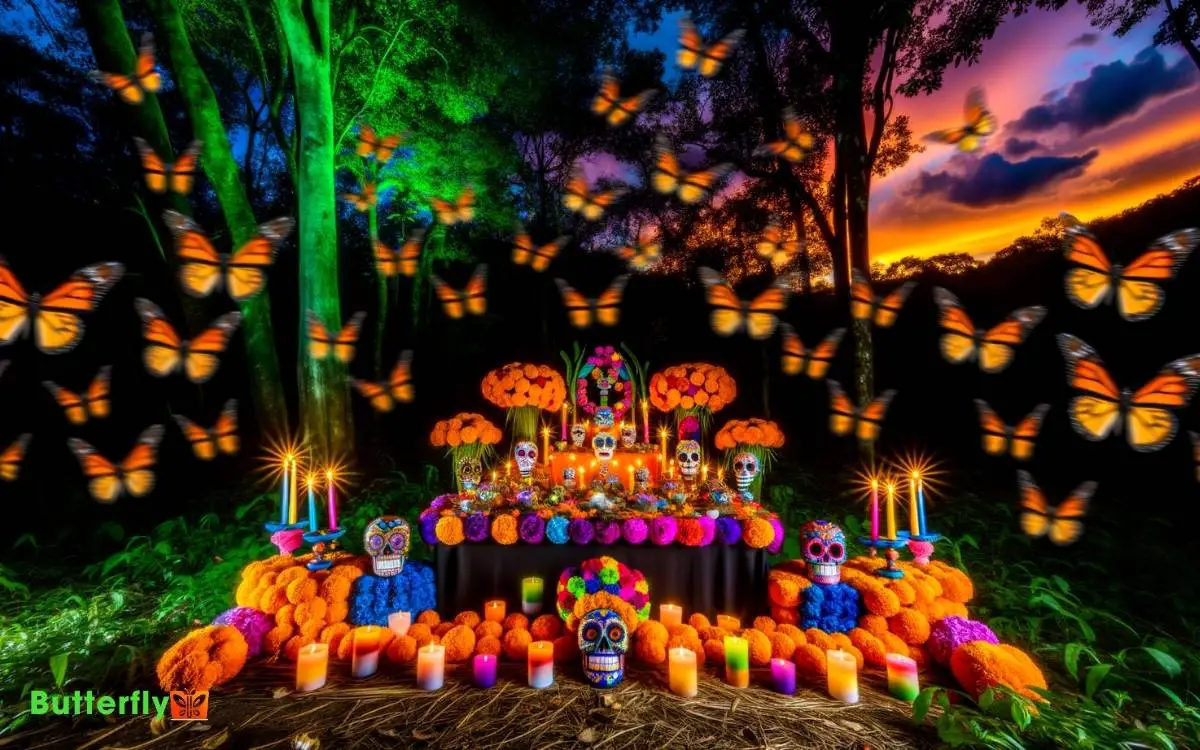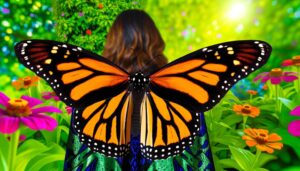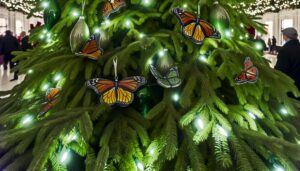Day of the Dead and Monarch Butterflies: Symbolic Connection
During Day of the Dead, you’ll find monarch butterflies deeply significant, symbolizing the spirits of deceased ancestors returning. This beautiful tradition goes back to ancient Mesoamerican rituals.
As monarchs migrate thousands of miles, their arrival in Mexico marks the return of loved ones, becoming a vibrant, spiritual bridge in the celebrations.
You’ll observe altars, or ofrendas, adorned with marigolds and personal items, connecting lives through shared stories.
Today’s environmental challenges like deforestation threaten these butterflies, making conservation essential.
This intertwines ecological efforts with cultural practices, highlighting life’s cyclical nature and a global sense of responsibility. Discovering the depths of these traditions offers a richer perspective.

Key Takeaways
Origins of Day of the Dead
The origins of Day of the Dead can be traced back to ancient Mesoamerican traditions, where indigenous cultures like the Aztecs honored their deceased ancestors with elaborate rituals and offerings.
By immersing yourself in these ancient customs, you’ll notice how they viewed death as a natural part of life, not an end but a shift. You can observe how they set up altars, known as ofrendas, adorned with marigolds, food, and personal items of the deceased.
This cultural practice emphasizes respect and remembrance, showing a unique perspective on mortality.
Understanding these rituals allows you to appreciate the deep-rooted significance and continuity of honoring the dead, transcending time and blending into the modern celebrations of Day of the Dead.
Significance of Monarch Butterflies
You’ll notice that the arrival of monarch butterflies during the Day of the Dead isn’t just coincidental. Observing their migration, you’ll see how these butterflies symbolize the spirits of the deceased returning to visit their loved ones.
Symbolic Cultural Representation
As you immerse yourself in the Day of the Dead celebrations, you’ll notice the Monarch butterflies are not just mere insects but profound symbols of ancestral spirits returning to the living world.
This cultural representation illuminates the deep connection between nature and spirituality in Mexican traditions. Observing the vibrant butterflies, you’ll sense the reverence and emotional significance they hold for the community.
| Symbol | Cultural Significance |
|---|---|
| Monarch Butterflies | Spirits of deceased ancestors |
| Migration Timing | Coincides with Day of the Dead |
| Arrival in Mexico | Symbolizes the return of loved ones |
Seasonal Migration and Arrival
Every autumn, countless Monarch butterflies undertake a remarkable journey from North America to the forests of central Mexico, aligning their migration with the Day of the Dead celebrations.
As you observe this natural phenomenon, you’ll notice that the arrival of these butterflies coincides with cultural rituals, creating a poignant and symbolic convergence.
From a cultural relativism perspective, local communities see these butterflies as the returning spirits of their ancestors.
Engaging in participant observation, you’d find that the people’s reverence for the butterflies reflects a deep respect for nature and ancestral traditions.
Symbolism and Beliefs
The intertwining of Day of the Dead traditions with the annual arrival of monarch butterflies in Mexico embodies a powerful cultural belief that these butterflies are the returning spirits of deceased loved ones.
By observing this phenomenon, you can gain a deeper understanding of its profound symbolism:
- Spiritual Connection: Monarch butterflies arriving during the Day of the Dead are seen as a spiritual bridge between the living and the dead.
- Cultural Significance: The butterflies’ arrival coincides with the celebration, reinforcing beliefs in the cyclical nature of life and death.
- Symbol of Hope: Their presence brings comfort and hope to those mourning, reminding them of the ongoing connection with their ancestors.
This blend of natural and cultural elements highlights the rich tapestry of Mexican traditions.
Migration Journey
You can witness the awe-inspiring migration journey of monarch butterflies as they traverse thousands of miles from North America to central Mexico. This incredible phenomenon isn’t just a biological marvel but also a cultural touchstone.
As you observe their meticulous flight, you’ll see them navigate diverse landscapes and climates. It’s a journey deeply intertwined with the lives and traditions of the people they encounter along the way.
Communities in Mexico eagerly await their arrival, seeing them as harbingers of the Day of the Dead. You’ll find that the butterflies’ arduous journey symbolizes endurance and transformation, resonating with the cultural significance they hold.
Engaging with this migration, you’ll appreciate the intricate relationship between nature and human culture.
Timing and Arrival
Amid the cool, crisp days of late October, monarch butterflies converge upon the highland forests of central Mexico, perfectly aligning their arrival with the Day of the Dead celebrations.
You witness this natural marvel as the butterflies’ timing intertwines with cultural events, creating a profound connection between nature and tradition.
Observing this, you notice:
- Consistency: Monarchs arrive almost predictably, showcasing their biological rhythm.
- Symbolism: Their appearance coincides with the belief that souls of the deceased return, enhancing spiritual significance.
- Environmental Cues: Temperature and daylight changes guide their journey, reflecting the intricate balance of nature.
Cultural Traditions
As you observe the Day of the Dead celebrations, you’ll notice the intricate altars and offerings that families create to honor their deceased loved ones.
Each item on the altar holds symbolic significance, from marigolds to the monarch butterflies believed to carry the spirits of the departed.
Altars and Offerings
Altars, known as ‘ofrendas,’ serve as a focal point in Day of the Dead celebrations, where families create intricate displays to honor and welcome the spirits of their deceased loved ones. You’ll find that these altars are rich in symbolism and deeply personal.
As you observe, consider the following elements often included:
- Photographs: These images help identify and invite specific spirits.
- Food and Drink: Traditional dishes and beverages, like pan de muerto and tequila, nourish the returning souls.
- Marigolds: Bright orange flowers called cempasuchil guide spirits with their vibrant color and scent.
Symbolic Significance
The vibrant elements adorning the ‘ofrendas’ aren’t just decorative but hold deep symbolic significance, reflecting cultural traditions that honor and remember the departed.
As you observe the marigolds, candles, and food offerings, you’ll notice each item has a specific meaning.
Marigolds, with their bright orange hue, guide spirits back to the living world. Candles serve as beacons of light, illuminating the path for the souls.
Food represents the earthly pleasures the deceased once enjoyed. Monarch butterflies, arriving in Mexico around the same time, are believed to carry the souls of ancestors, symbolizing the cyclical nature of life and death.
Altars and Offerings
In Mexican culture, altars and offerings during the Day of the Dead serve as a profound way to honor and remember deceased loved ones. Observing these altars, you notice the intricate and symbolic elements that invite spirits to partake in the celebration.
Key components often include:
- Marigolds (Cempasúchil): Their bright orange color and scent guide spirits back.
- Ofrendas (Offerings): Food, drinks, and personal items cater to the tastes of the departed.
- Photographs: Images of the deceased help to evoke memories and make the connection personal.
Spiritual Connection
During the Day of the Dead, you can feel a profound spiritual connection as the boundary between the living and the dead becomes permeable, allowing souls to reunite with their families.
Observing this, you see how deeply personal and communal this celebration is. Monarch butterflies, arriving in Mexico, are believed to be the returning souls of deceased loved ones. This belief enhances the sense of unity between humans and nature.
| Aspect | Observation |
|---|---|
| Spiritual Practices | Altars, offerings, and rituals |
| Symbolism | Monarch butterflies as soul carriers |
| Community Impact | Strengthened family and community bonds |
You notice that cultural relativism is key here; understanding these practices within their cultural context reveals their profound significance. Your participation offers a unique lens into this rich tradition.
Environmental Impact
As you immerse yourself in the Day of the Dead festivities, you can’t ignore the environmental impact of the monarch butterflies’ migration, highlighting the delicate balance between cultural practices and ecological preservation.
Observing this phenomenon, you notice how:
- Deforestation: Logging disrupts their habitats, making their journey more perilous.
- Climate Change: Altered weather patterns affect their migratory routes and survival rates.
- Pesticides: Agricultural chemicals harm the milkweed plants essential for their lifecycle.
Conservation Efforts
You notice how habitat preservation initiatives are essential for maintaining the delicate balance between the Monarch butterflies and the Day of the Dead traditions.
By engaging local communities, you’re participating in programs that foster both environmental stewardship and cultural heritage.
These efforts highlight the interconnectedness of natural ecosystems and cultural practices.
Habitat Preservation Initiatives
In the vibrant tapestry of cultural and ecological landscapes, habitat preservation initiatives for monarch butterflies are essential to maintaining both the biodiversity and the cultural heritage intertwined with the Day of the Dead celebrations.
By participating in these initiatives, you’re contributing to a cause that transcends mere environmentalism.
You’re helping to:
- Protect critical migratory pathways: Monarchs traverse thousands of miles, needing safe havens along the way.
- Maintain native plant species: Milkweed and nectar plants are essential for monarch survival.
- Foster ecological balance: Monarchs play a pivotal role in pollination, affecting diverse ecosystems.
Community Engagement Programs
Engaging local communities in conservation efforts not only fortifies the habitats of monarch butterflies but also deepens the cultural connection to the Day of the Dead celebrations.
By participating in educational workshops and habitat restoration projects, you’ll see firsthand the pivotal role these butterflies play in local traditions.
Observing community-led initiatives offers insights into how cultural practices and environmental stewardship intertwine.
This involvement fosters a shared responsibility, emphasizing that both the natural and cultural heritage are worth preserving.
Participating in these programs enables you to understand the symbiotic relationship between the butterflies and the Day of the Dead, highlighting the importance of maintaining these delicate ecosystems.
Your engagement becomes an essential part of a larger, culturally rich conservation effort.
What is the Symbolic Connection Between Monarch Butterflies and Day of the Dead?
The symbolic connection between Monarch butterflies and Day of the Dead is deeply rooted in Mexican tradition. These butterflies and their symbolism are believed to represent the souls of departed loved ones returning to visit the living. Their vibrant orange and black colors are thought to embody the spirits of the deceased during this sacred time.
Personal Stories
Maria’s grandmother always believed that the arrival of the monarch butterflies signaled the presence of their ancestors during the Day of the Dead celebrations.
You can observe how this belief is deeply woven into the cultural fabric of their community. Witnessing these butterflies fluttering around, you might feel a profound connection to the past. This belief isn’t just a tale but a lived experience for many.
- Symbolism: Monarch butterflies represent the souls of departed loved ones.
- Rituals: Families create altars adorned with marigolds and offerings, inviting the butterflies.
- Community Bonding: Sharing stories about ancestors strengthens communal ties.
Global Awareness
Although the Day of the Dead is rooted in Mexican tradition, its significance and practices resonate globally, fostering a deeper understanding and respect for cultural diversity.
When you observe this celebration, you’re not just partaking in a cultural event; you’re embracing a worldview that honors life and death in a unique way.
Many cultures now incorporate elements of the Day of the Dead, blending traditions and fostering global unity.
| Aspect | Global Influence |
|---|---|
| Symbolism | Universal themes of life and death |
| Practices | Adapted in multicultural events |
| Cultural Exchange | Promotes mutual respect and learning |
Conclusion
You’ve journeyed through the profound mysticism of the Day of the Dead and the majestic migration of monarch butterflies.
You’ve witnessed how these ethereal creatures, with wings that paint the sky, embody the souls of the departed, bridging two worlds.
It’s staggering to see how deeply this belief shapes communities. You’ve felt the urgency of conservation, knowing every butterfly saved is a spirit preserved.
Embrace this cultural tapestry, and you’ll never view butterflies the same again.







Can you be more specific about the content of your article? After reading it, I still have some doubts. Hope you can help me.
Can you be more specific about the content of your article? After reading it, I still have some doubts. Hope you can help me.
Thanks for sharing. I read many of your blog posts, cool, your blog is very good.
Your point of view caught my eye and was very interesting. Thanks. I have a question for you.
Thanks for sharing. I read many of your blog posts, cool, your blog is very good.
Thanks for sharing. I read many of your blog posts, cool, your blog is very good.
Your point of view caught my eye and was very interesting. Thanks. I have a question for you.
I don’t think the title of your article matches the content lol. Just kidding, mainly because I had some doubts after reading the article.
Your point of view caught my eye and was very interesting. Thanks. I have a question for you.
Thank you for your sharing. I am worried that I lack creative ideas. It is your article that makes me full of hope. Thank you. But, I have a question, can you help me?